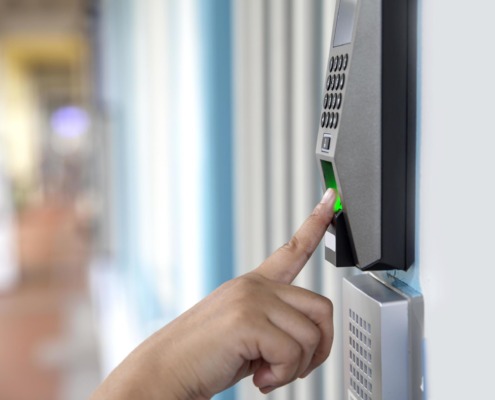What are the Three Types of Access Control? Learn the Essentials for Your Business
 In the world of cybersecurity, access control is a crucial aspect to consider for any business. It refers to the process of allowing or denying individuals or devices access to resources within a system or network. By implementing effective access control solutions, businesses can ensure that only authorized users have access to sensitive information and resources.
In the world of cybersecurity, access control is a crucial aspect to consider for any business. It refers to the process of allowing or denying individuals or devices access to resources within a system or network. By implementing effective access control solutions, businesses can ensure that only authorized users have access to sensitive information and resources.
There are three main types of access control that are commonly used in organizations: mandatory, discretionary, and role-based access control (RBAC). Each type has its own unique characteristics and benefits, making it important for businesses to understand which one suits their needs best. This article will dive deeper into each type and the essentials you should know, including why partnering with a local IT support provider can be beneficial for your business.
Article Summary:
- Understanding Access Control: An Overview
- Discretionary Access Control (DAC) Explained
- Exploring Mandatory Access Control (MAC)
- Role-Based Access Control (RBAC): The Modern Approach
- Comparing DAC, MAC, and RBAC: Pros and Cons
- Implementing Access Control Systems: Key Considerations
- The Benefits of Effective Access Control
- Current Trends in Access Control Technology
1. Understanding Access Control: An Overview
Before delving into the specifics of each type, it is essential to have a basic understanding of access control. In simple terms, access control refers to the methods and policies used by organizations to manage and monitor access to resources within their systems or networks.
To better understand this concept, think of a locked door with a key. The key acts as the means for authorized individuals to gain access to the room behind the door. Similarly, in an organization’s network or system, access control ensures that only individuals with proper authentication are granted access.
Access control can be achieved through various methods such as passwords, biometric scans, security tokens, and more. These methods ensure that only authorized individuals, devices, or processes can access sensitive data and resources.
2. Discretionary Access Control (DAC) Explained
Discretionary access control is the most basic type of access control. In this model, the owner of a resource decides who has access to it and what level of access they have. The owner also has the ability to modify these permissions at any time.
For example, in a DAC system, an employee may have permission to access certain files within a shared drive based on their job role. However, if their role changes or they leave the company, their permissions can be revoked by the owner.
One drawback of this type of access control is that it relies heavily on the owner’s discretion, making it difficult to enforce strict security measures.
3. Exploring Mandatory Access Control (MAC)
Unlike DAC, mandatory access control is a more rigid and systematic approach to controlling access. In this model, all resources are categorized and assigned a security level based on their sensitivity. Users are also assigned clearance levels that determine what resources they can access.
For instance, in a MAC system, an employee with a low-level clearance cannot access highly sensitive data even if they have permission from the owner.
This type of access control is commonly used in government agencies or organizations dealing with classified information. It ensures that only authorized personnel have access to certain resources and minimizes the risk of unauthorized disclosures.
4. Role-Based Access Control (RBAC): The Modern Approach
Role-based access control is the most widely used access control model in modern organizations. It combines aspects of both DAC and MAC to provide a more flexible and efficient approach.
In RBAC, access is granted based on an individual’s job role or responsibilities within the organization. Each role is assigned a set of permissions, making it easier for administrators to manage access control as employees move between roles or leave the company.
For example, in an RBAC system, a manager may have permission to view and edit files within their team’s shared drive, while a regular employee can only view the files.
5. Comparing DAC, MAC, and RBAC: Pros and Cons
Each type of access control system has its own advantages and disadvantages. DAC offers flexibility but can be challenging to manage in larger organizations. MAC provides strict control but can be inflexible. RBAC combines the benefits of both models, making it a popular choice.
When deciding which type to implement, businesses should consider their specific needs and resources.
6. Implementing Access Control Systems: Key Considerations
Implementing an access control system requires careful planning and consideration. Some key factors to keep in mind when choosing which type of access control technology is right for your business include:
- Identifying critical resources and their sensitivity levels.
- Defining user roles and their corresponding permissions.
- Establishing proper authentication methods such as passwords or biometric scans.
- Regularly reviewing and updating access permissions.
7. The Benefits of Effective Access Control
 Effective access control has numerous benefits for businesses, including:
Effective access control has numerous benefits for businesses, including:
- Protecting sensitive data from unauthorized access.
- Reducing the risk of data breaches and insider threats.
- Ensuring compliance with regulations and industry standards.
- Enhancing overall security posture.
- Keeping your business safe
8. Green Bay & Appleton Access Control
By implementing an appropriate access control system, organizations can confidently secure their resources and protect against unauthorized access. It is a crucial aspect of overall information security that should not be overlooked. For small businesses seeking Green Bay & Appleton access control, consider RanderCom.
At RanderCom, we’re dedicated to enhancing the operations of small businesses with our comprehensive managed IT support and services. We ensure your technology infrastructure is both secure and seamlessly integrated. Our team excels in providing top-notch IT solutions from surveillance and security systems to access control. Call RanderCom today to learn more about how we can help your business thrive.
By Steve Lindstrum, Owner of RanderCom
Steve Lindstrum is the proud owner of RanderCom, serving Appleton, Green Bay, and communities across Wisconsin. At RanderCom, Steve and his team offer comprehensive small-business technology solutions. Services include the sales and installation of phone systems, surveillance systems, access control systems, paging & intercom systems, voice & data services, data cabling & wiring, and IT network equipment. With years of experience in installing business phone systems and other systems, you can trust RanderCom to meet your small business tech needs. Contact us today!




